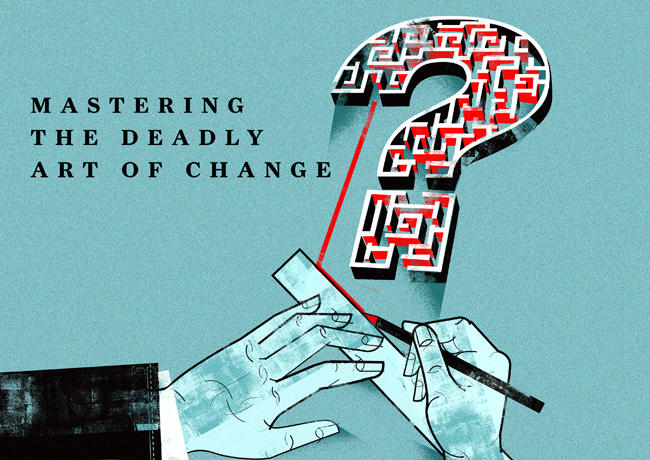by Alicor Panao, Editor-in-Chief, The HR Agenda
Furman University professor and seventh-degree Aikido master David Shaner tells his followers to be compassionate. He wants them to be relaxed but at the same time conscious of all their actions. He talks about how the individual should deal with a universe constantly in flux—the kind of talk you usually hear from a Buddhist monk. But instead of a gi, Shaner dons a suit. His followers are corporate executives and top level managers. The boardroom is his dojo.Think of it as a Zen approach to business transformation. Only this time, the organization is no longer the focus. Shaner, who holds the Herring Professor of Asian Studies and Philosophy chair at Furman University, says change must first take place in individuals if an organization is to see lasting transformation that leads to profitability and sustainability.
CHANGE: Where does it begin?
“Before organizational change can succeed, it must first occur at the subtle spiritual level in the individuals of the organization,” notes Shaner. “All lasting transformation must begin there because, ultimately, your spirit and mine is the primary driver of all our behavior.”
This may sound a bit out of touch with reality. Shaner, however, is not just blurting out Eastern philosophy, but is actually drawing from over twenty years of experience as consultant for world-class companies such as Umbro, Frito-Lay, Ryobi, Duracell, Gillette and Owens-Corning Composites. Shaner, who has taught at Harvard and Furman, is also principal of CONNECT Consulting, LLC, which not only helps create sustainable performance improvement for corporations but offers counseling for those who seek a committed “Seven Arts” approach to sustainable change. This approach is the subject of his latest book, “The Seven Arts of Change: Leading Business Transformations That Lasts” which is slated for launch in November.
Shaner’s focus on the individual makes sense when one realizes that at the core of all businesses are human energies that are applied in an organized environment. What is referred to as organizational culture actually refers to people believing, behaving, and expecting in a collective manner.
“Corporate culture is neither in your brand, nor in your intellectual property, it is in your people,” says Shaner. “It is in their habits, it is in their views of their relationship with the company.” Since its core ingredients are intangible, an organization can hardly be expected to change if nothing is being done about the collective mind that dictates the activity of its culture. “If you want to literally change the company, then you have to start with every single individual and help him understand why it is beneficial for him to change,” says Shaner.
CHANGE: Top-Down or Bottom-Up?
But who should be the change driver? Must it be HR?
Shaner believes the initiative has to come from the CEO. Unless the CEO is completely and utterly committed to drive the change process, it is just like burying the idea in the mid-level training department. And HR managers agree, according to Shaner, because they know that acting alone the training department will not be able to transform the organization. Shaner himself makes it a point that when he consults for a company, his contract is signed by the CEO and not just the HR head. “That is not putting HR down,” he points out, “that is actually saying that this (managing change) is vitally important.”
Is it possible to drive change from the bottom up? Shaner says yes, but he qualifies. It is not uncommon for people to come across good practices worth emulating in their own organizations. When ordinary people begin practicing the principles of sustainable change and share it with others in the workplace, it is possible for them to funnel up to the attention of the leader of the company, including the board. But change may still be difficult if they do not have the right system, the right information, or the right resources. “Change may require additional overtime for employee training, for instance,” Shaner explains. “Or having the right infrastructure may require spending an additional six million dollars for, say, Oracle to upgrade the system,” he adds, using a recent client’s experience as an example.
Sometimes a company may need to hire lean consultants to look into the manufacturing process. Change then means convincing the board to give additional millions of dollars to a company that already looks like it is tanking and explaining to them that this additional cost is really necessary to turn it around.
Stakeholders of Change and “Boardroom Awareness”
Shaner also believes in making each employee some sort of owner. This means involving them meaningfully in the direction of the business and allowing them to participate in the rewards that accompany superior achievement. Naturally, once people are given a clear reason, they themselves will want to embrace change.
Building change from the ground up means that the employees have a clear understanding of what is needed to be done and the board willing to invest in their education instead of just letting them go belly-up. Shaner insists it is still possible for a company which is already on the brink of bankruptcy to become profitable and compete—even in times of economic slowdown. “The key is to help employees control their own destinies and give them the proper training to literally change the way they work,” he explains. “This means making them understand why it is necessary to improve quality and productivity, and why they should not be moaning about their wages since their company already pays them five times more for a product that their competitor produces with better quality.”
Shaner believes in the importance of giving each person in the company boardroom awareness. “Every person on the floor needs to understand the business as if they are board members,” he explains. “That means they have to understand the business model of the companies that are out there, ready to put their jobs on the line and make the entire member of their family out of work.”
Of course, there are hard truths that have to be accepted in the process. Taking a lean path, for instance, means doing more with less. “There are processes that need to be eliminated,” Shaner admits. And in this case it is best to tell the truth. Everyone is better off if the company will tell it straight that if it is to survive it has to rightsize by, say, 10 percent of what it currently has. Rather than keeping it from employees to the point of giving them stress, Shaner advises companies to ask employees whether they want to rightsize and survive, or hold on and risk shutting the company to everyone’s detriment. Based on Shaner’s experience, affected employees find it easier to buy the idea of giving up their jobs if companies are more transparent and give them option to decide. Companies in turn can offer employees accelerated retirement.
Is it possible to accelerate change?
There is also no quick fix to transforming an organization. There are of course people who claim they can change an organization within six months. Change, however, is not easy and organizations who embark on it usually fail 70 percent of the time. And Shaner believes those companies who think they can transform in six months are among the 70 percent that are likely to fail.
“I would be lying if I say that in six months I can change the company,” says Shaner. This is because without the right preparation and foundation, any change process will not take hold and the effort will just end in failure. Change rarely occurs in a moment, except in rare instances like an unexpected tragedy or severe disaster. If change is difficult enough for an individual—some take a lifetime to achieve any sustainable change in their lives—how much more for an organization.
Dealing with Change Resisters
How do you now deal with people who stubbornly resist change? Shaner offers a two-fold approach. The first is to deal with them with compassion. “All of us resist change one way or the other,” Shaner explains. “So rather than singling one person out, I would rather approach that person with compassion.”
The second part is basically just allowing the system to correct itself. If an organization has embraced change well enough as to make it part of the reward system, HR does not even have to bother with those who resist change. Individuals in an organization usually work on inter-related functions and must rely upon one another to perform these functions. Performance schemes may be tied to the achievement of specific results such that if an employee does not perform he or she will be directly or indirectly causing those around him to fail. Checks will not come from HR but peers, because those who resist change are, in effect, costing other people their reward.
Shaner believes it is not difficult to sell change and his formula is deceivingly simple. “I try to help management understand that everyone in the company are all just big kids wanting to know the ‘whys.’ if you give them a good understanding of the landscape, tell them who the competitors are, and how their jobs is in jeopardy, it will not induce fear.”
When an organization works on this approach, every person in the company will feel more secure and come home a happier family man or woman. They will not bring their problems home and be short with their kids and spouse.
“They are actually going to like going to work, and that for me, is a beautiful thing,” says Shaner.
Other posts by The Japan HR Society:







